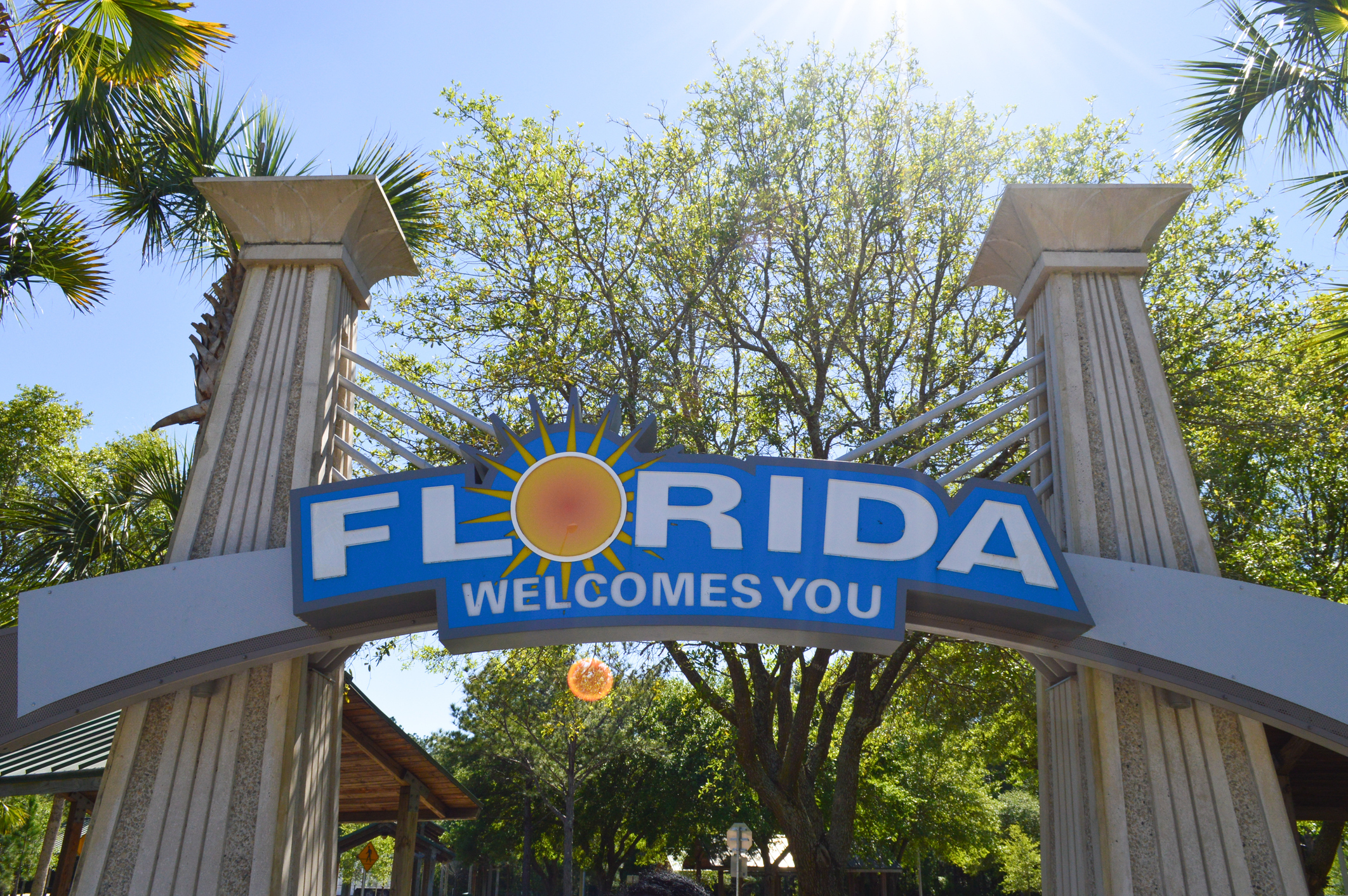Why Do People Retire in Florida? 9 Things You Must Know
Why do people retire in Florida? Attention Florida-bound retirees: There's more to the Sunshine State than Disney, golf and beaches.

Kathryn Pomroy
Why do people retire in Florida? Besides the sunshine, sandy beaches and oranges, people approaching retirement age crave a warmer climate to call home in their golden years, especially if they live in the snow and cold for most of the year. So, as you sit there mulling over a happy retirement in the Southeast or Midwest, thousands of others have already packed up their belongings and are on their way to Florida. And the facts back it up.
Florida saw its population surge by more than 467,000 people in 2024, according to an estimate released by the United States Census Bureau. Not only is the state's weather a strong draw, but Florida also has no income or estate taxes, and property taxes are relatively low compared with other states.
But Florida has a lot more to offer than just beaches. Disney World, warmer temps and the massive retirement community known as The Villages compete as top draws for retirees. You'll want to consider everything about the state before packing up and heading south, though. We recommend you "try before you buy" — spend an extended period in the Sunshine State to get to know the place before you make a move.
From just $107.88 $24.99 for Kiplinger Personal Finance
Be a smarter, better informed investor.

Sign up for Kiplinger’s Free Newsletters
Profit and prosper with the best of expert advice on investing, taxes, retirement, personal finance and more - straight to your e-mail.
Profit and prosper with the best of expert advice - straight to your e-mail.
Here's what you need to know about retiring to Florida. So grab an OJ and dive on in. The water’s warm, but...complex.
1. Prepare for harsh weather
Sure, Florida has great weather. After all, it is called the Sunshine State for a reason. But don't expect every day to be sunny. Thunderstorms in Florida are frequent and intense. The Atlantic hurricane season lasts six months, from June 1 until the end of November, and peaks between mid-August and late October. Since 1850, all of Florida’s coastline has been impacted by at least one hurricane.
The 2024 hurricane season had above-normal activity and tied with 1871, 1886, 1964, 2004 and 2005 for the most hurricanes to make landfall in Florida in a single season. (Do you see the pattern here?) The likelihood of harsh weather can affect the financial benefits of moving to Florida. Florida residents pay a lot more in insurance to protect their property. More on that below.
2. You'll need plenty of insurance in Florida
The risk of hurricanes and tropical storms makes insuring your home in Florida much more complex and expensive than it is in many other areas of the country. In many hurricane-prone areas, insurance companies often require property owners to not only purchase homeowners insurance but also flood insurance and sometimes even windstorm coverage.
“The cost to insure a home without wind mitigation features could be four times higher than a home with wind mitigation,” says Chris Heidrick, founder of Heidrick & Co. Insurance in Sanibel, Florida.
Floods aren't covered by a standard homeowners policy, but you can get coverage from the National Flood Insurance Program. The Federal Emergency Management Agency (FEMA) reports that an average National Flood Insurance Program (NFIP) policy costs about $786 per year, based on 2023 data. The National Flood Insurance Program (NFIP) puts that figure at approximately $853 to $964 per year, according to 2024-2025 data.
However, many insurance companies in Florida are leaving the state entirely. Others are choosing to significantly raise rates, limit coverage and even cancel policies. For example, in July 2023, AAA announced it would no longer be renewing some policies with home, auto and umbrella bundles in Florida, and Farmers Insurance pulled out of Florida entirely, affecting 100,000 policies.
For this reason, the availability of coverage and cost of premiums can vary considerably. Plus, expect to pay a higher deductible for hurricane damage — generally, 5% to 10% of your coverage amount for damages caused by a hurricane. The Florida Office of Insurance Regulation has a great Rate Comparison Tool that provides premium estimates from insurers in your county.
Overall, it’s important to find out about the insurability of a home before buying it, so you don’t end up with annual premiums that are several thousand dollars more than you were expecting to pay.
Read: Do You Need Home Insurance?
3. Florida’s a lot less taxing
Moving to the Sunshine State could save you a lot of money in taxes. Florida, one of the 10 most tax-friendly states for retirees, has no state income tax. That means no state taxes on Social Security benefits, pensions, IRAs, 401(k)s and other retirement income. It also has no inheritance tax or estate tax.
But snowbirds who maintain a second home in a colder state can’t just tap their heels together to establish residency in Florida for tax purposes. You’ll need to show that you spend more than half the year — 183 days — in Florida. And don’t expect state tax auditors to take your word for it. For starters, keep a diary or log showing the number of days you spend in each state during the year, says Tim Steffen, director of advanced planning for Robert W. Baird.
Here's what else to do:
- Register to vote in Florida, and if you receive a jury summons, perform your civic duty
- Apply for a library card
- Change your driver’s license and car registration
- Establish relationships with health care providers in your new location
- Open an account at a local bank, and keep receipts of ATM withdrawals
- Shop locally: State tax auditors sometimes review credit card records to determine where you were during the year
- File a Declaration of Domicile with your local county court
4. The state's population is growing fast
Retiring to Florida? Expect lots of company. Florida is already the third most populated state and just keeps growing.
The U.S. Census Bureau reported in December 2024 that Florida's population soared to more than 23.3 million residents. Florida was second only to Texas in population growth in 2024. Texas added 562,941 residents last year, while Florida added 467,347 new citizens. Before that, between 2021 and 2022, Florida’s population increased by 1.9%, making it the fastest-growing state for the first time since 1957.
And out of the top ten fastest-growing metro areas (between July 2022 and July 2023), Florida is home to four. By 2030, the number of seniors in the Sunshine State is expected to increase by several million. So, depending on where you land, expect to be surrounded by people who look like you, grey hair and all.
“Everything is geared toward retired, older people,’’ said one resident, a January 2012 transplant from upstate New York who owns a home in Fort Myers Beach (Gulf side). “All the commercials are about things like walk-in bathtubs, insurance, Lifeline, i.e., ‘I've fallen and I can't get up.’ So many volunteer activities are during the workday. It's like they don't think people move down here to work.”
5. Florida’s tourists can slow you down
Don't underestimate the amount of tourists who pour into Florida every year. If you visited Walt Disney World when you were a kid, you probably marveled at the crowds. As a resident, you’ll probably only be annoyed by them. In 2024 alone, Florida welcomed a record-breaking 142.9 million visitors, according to VISIT FLORIDA and Governor Ron DeSantis’ office. That's a lot of people converging on the state’s famous theme parks, beaches and destination spots, such as the Keys and Everglades National Park.
Think of all those tourists on the road as you try to run errands. Major headache.
6. Yes, there's such a thing as TOO much sun
Beach bums in the swingin' '70s knew nothing of SPF. It was baby oil, baby, slathered on your tender skin to enhance rays of sunshine to deepen your tan. Little did we know the dangers.
The sun on exposed skin was dangerous then and is dangerous now, especially if you're a tenderfoot moving from the Midwest or Northeast to year-round sunshine in tropical Florida. Sunburn can cause premature wrinkling and uneven skin coloring. And too many sunburns or too much sun will cause your skin's texture to change.
"The skin can become tough and leathery," according to the Florida Institute of Neuroscience. "You may also notice more wrinkles. The sun can also cause brown, red, yellow, or gray spots in the skin called sun spots."
And the most serious result of too much sun, of course, is skin cancer. Your risk of getting skin cancer increases the more sun exposure and sunburns you have. So be careful. SkinCancer.net reports that Florida is number two in the nation for the highest rate of melanoma cases.
Sun worshippers are urged to stop sunbathing, avoid the sun between 10 a.m. and 4 p.m. (when the sun's rays are most damaging), and use broad-spectrum sunscreens. And when you are on the beach, sit under an umbrella or some other shaded protection from the sun.
7. Housing supply is increasing
Previously, Florida, like elsewhere in the country, was low on home inventory in this seller's market. But recently, Florida has faced the opposite problem — an increase in building and inventory and not enough buyers. Earlier this year, there was a surge in the number of homes for sale on the Gulf Coast of Florida, according to Redfin. Specifically, the number of homes for sale in Cape Coral, FL and North Port, FL, surged roughly 50% from a year earlier in March, more than anywhere else in the country.
Of the 10 metro areas that experienced the largest year-over-year increases in supply, six are in Florida. As mentioned, Cape Coral, FL saw the biggest jump in homes for sale (51%), followed by North Port-Sarasota, FL (48%), Fort Lauderdale, FL (30%), Tampa, FL (29%), Orlando, FL (23%) and West Palm Beach, FL (20%). The consequence of this? Sellers are slashing prices in these areas.
“Out-of-town homebuyers no longer see Florida as a place to get amazing value for a low price. Now they’re moving to North Carolina or Tennessee to get a good deal," Eric Auciello, a local Redfin sales manager, says in the report. He goes on to say: "My advice to sellers is to price your home fairly; the comps from six months ago don’t exist now. And if you’re a buyer, know that the odds of getting an offer accepted below market value are pretty high.”
Of course, you're still going to find luxurious waterfront homes for several million dollars in many Florida communities, but the 2025 average Florida home value is $392,262, up 0.5% from the previous year. For comparison, the average United States home value is $367,969, up 0.8% over the past year, according to Zillow.
8. Life’s not always a beach in Florida
There’s often a major misconception about Florida as a retirement destination: Many think the state is one big beach or, an easy-to-reach beach. Not so. Those world-famous theme parks? They’re in Orlando, in the middle of the state, an hour or so car ride to the beach.
“People who are thinking about a move to Florida should really explore the state,” says Dania Perry, a real estate agent with Century 21 Jim White & Associates in St. Petersburg. “Each of Florida's metro areas has its own vibe. The east and west coasts of Florida are very different, as different as the Gulf of Mexico and the Atlantic Ocean. North Florida features vast stretches of rolling hills and countryside.”
You already know the big destinations: Orlando, home to Disney World, Universal Studios and their smaller ilk; Miami, if you want to live out your “Miami Vice” or “Golden Girls” fantasies (whatever floats your boat; we’re in a no-judgment zone); and the Florida Keys for a laid-back lifestyle as far south as you can go in the state.
But other Florida towns belong on your Florida Retirement Planning Tour. Fort Myers Beach, for example. You’re right on the Gulf (or close to it), there are plenty of 55-and-older communities, yet it remains youthful during the high season, with plenty of young people flocking to the resort area with its boardwalk and bars.
Sarasota has plenty of beaches, and the small city moves a bit slower than some of the larger towns in Florida. There is a wide array of restaurants and stores in St. Armands Circle, the island shopping center. Another bonus: access to the Sarasota Memorial Health Care system, which is one of the largest medical centers in Florida.
Is retiring to a college town — to teach part-time, take college courses (free for people age 60 or older), or just hang out with the young’uns — a must for you? Check out Gainesville, home of the University of Florida. But bear in mind that Gainesville is deep in the heart of Florida, 75 miles from any beaches.
9. Florida has lots of creepy, crawly things
Florida is its very own ecosystem, and the state’s various creatures may do more than make your skin crawl. They might also eat into your budget.
For instance, dealing with termites is just part of the routine for Florida homeowners. In 2024, Miami ranked #1 on Orkin’s Top 50 Termite Cities list for the second year in a row. Tampa is #3 on the list, with Orlando at #8 and West Palm Beach at #9.
A termite inspection by a pro ranges from free to $325, with an average of around $150. The average cost for tent treatment of termites was anywhere from $1,000 to $10,000 in 2024, depending on the square footage.
Then there are the rats — on the beach, in the trees, and perhaps on your roof, too. Yes, they are the same rats you know and loathe; they've just adapted to the climate and are called, among other things, palm rats and roof rats. Rat control can cost homeowners upward of $400 a year.
As a Floridian, you’ll also have to keep an eye out for alligators, panthers, and pythons. Oh my. Florida has an estimated 1.3 million alligators of the approximately five million in the U.S., and you might encounter them slinking across a golf course or gliding in backyard swimming pools.
“Beware of Alligators” signs are posted at lakes, lagoons, parks, ponds, golf courses and elsewhere throughout Florida. Alligator attacks are rising partly due to rising temperatures, development and people visiting their habitat more frequently, Florida Fish and Wildlife Conservation Commission experts say. In 2024, Florida recorded 487 unprovoked human alligator bites since tracking began in 1948, with 339 classified as major bites and 27 as fatal.
Panthers, the state animal of Florida, are another tale. While there have been no documented panther attacks on humans, they do dine on pets and livestock. An estimated 120–230 adult panthers are living primarily in South Florida’s wild areas like the Everglades and Big Cypress National Preserve
Besides panthers and other nasty pests, Burmese pythons, which aren’t native to Florida, are also growing in numbers in Everglades National Park — and showing up in homeowners’ pantries, cars, laundry rooms and other spots.
Last word
While Florida offers long lazy days of sunshine, sandy beaches, tax advantages, reasonably priced homes (at least for now), a low cost-of-living for retirees and a steady economy, the cost of insurance, sub-par healthcare (sadly, Florida ranks 36 out of 50 states regarding the quality of healthcare), urban crime rates and a heat index that can reach 110 degrees, may make you think twice about retiring in the Sunshine State. Before packing your bags, check out why some retirees are bypassing Florida for other states that offer a better quality of life.
Related Content
Profit and prosper with the best of Kiplinger's advice on investing, taxes, retirement, personal finance and much more. Delivered daily. Enter your email in the box and click Sign Me Up.

Bob was Senior Editor at Kiplinger.com for seven years and is now a contributor to the website. He has more than 40 years of experience in online, print and visual journalism. Bob has worked as an award-winning writer and editor in the Washington, D.C., market as well as at news organizations in New York, Michigan and California. Bob joined Kiplinger in 2016, bringing a wealth of expertise covering retail, entertainment, and money-saving trends and topics. He was one of the first journalists at a daily news organization to aggressively cover retail as a specialty and has been lauded in the retail industry for his expertise. Bob has also been an adjunct and associate professor of print, online and visual journalism at Syracuse University and Ithaca College. He has a master’s degree from Syracuse University’s S.I. Newhouse School of Public Communications and a bachelor’s degree in communications and theater from Hope College.
- Kathryn PomroyContributor
-
 Why is My First Medicare Bill So High?
Why is My First Medicare Bill So High?Your first Medicare bill may be higher than expected for several reasons. If your premiums aren't taken out of your Social Security benefit, the bill can be huge.
-
 11 Unforgettable Road Trips to Take in Retirement
11 Unforgettable Road Trips to Take in RetirementMore than a travel trend, the road trip is a quintessential American tradition, with millions of us taking them each year. Here's a guide to helping you choose your next adventure.
-
 Why is My First Medicare Bill So High?
Why is My First Medicare Bill So High?Your first Medicare bill may be higher than expected for several reasons. If your premiums aren't taken out of your Social Security benefit, the bill can be huge.
-
 11 Unforgettable Road Trips to Take in Retirement
11 Unforgettable Road Trips to Take in RetirementMore than a travel trend, the road trip is a quintessential American tradition, with millions of us taking them each year. Here's a guide to helping you choose your next adventure.
-
 I'm a Financial Professional: Here Are Four Ways You Can Use Debt to Build Wealth
I'm a Financial Professional: Here Are Four Ways You Can Use Debt to Build WealthUsing debt strategically, such as for homeownership, education and more, can lead to greater financial stability and growth.
-
 Five Key Wake-Up Calls for Ambitious Business Owners, From a Biz Specialist
Five Key Wake-Up Calls for Ambitious Business Owners, From a Biz SpecialistYour personal financial plan needs to include a formal exit strategy for your business, or you could be in trouble.
-
 4 Career Moves to Make Now if You're Worried About a Recession
4 Career Moves to Make Now if You're Worried About a RecessionWorried about a recession? These steps to protect your job prospects will help you professionally whether a downturn develops or not.
-
 How StoryCorps Works and How You Can Tell Your Story
How StoryCorps Works and How You Can Tell Your StoryStoryCorps has recorded conversations between thousands of people, and anyone can participate. National facilitator Alan Jinich explains how to share your story.
-
 Vacation Couture: Why Wealthy Americans Are Flying to Europe to Save on Luxury
Vacation Couture: Why Wealthy Americans Are Flying to Europe to Save on LuxuryTariffs are making high-end shopping in the U.S. pricier — so savvy travelers are heading overseas, where VAT refunds and favorable exchange rates can offset the extra cost.
-
 I'm a Retirement Psychologist: Here's Why Doing What You 'Ought' in Retirement Beats Doing Whatever You Want
I'm a Retirement Psychologist: Here's Why Doing What You 'Ought' in Retirement Beats Doing Whatever You WantTrue retirement freedom isn't about simply doing whatever you want, but about finding purpose and direction through commitments that align with your deepest values and allow you to contribute meaningfully.

